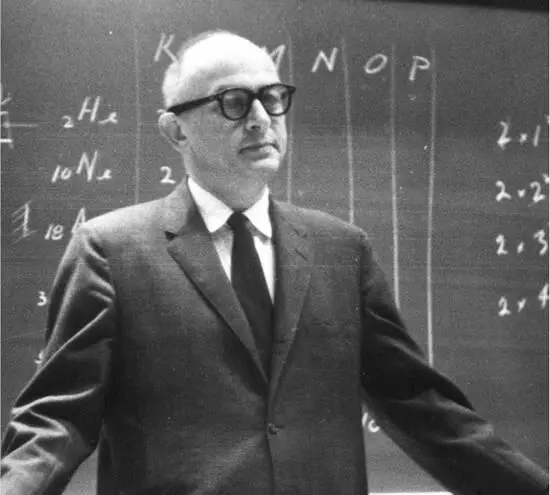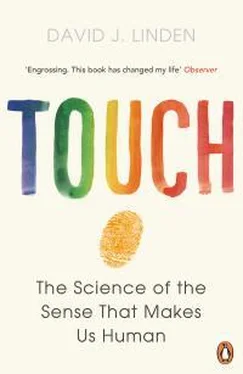You may ask, “Okay, I understand that kids are sensitive, but once we’ve become adults, why does it matter if we’re touch-deprived? This touchy-feely stuff is for hippies and time wasters. Just squirt out another glob of hand sanitizer (with that deeply satisfying blorp sound) and get back to work.” The answer is that interpersonal touch is a crucial form of social glue. It can bind sexual partners into lasting couples. It reinforces bonds between parents and their children and between siblings. It connects people in the community and in the workplace, fostering emotions of gratitude, sympathy, and trust. People who are gently touched by a server in a restaurant tend to leave larger tips. Doctors who touch their patients are rated as more caring, and their patients have reduced stress-hormone levels and better medical outcomes. Even people with clipboards at the mall are more likely to get you to sign their petitions or take their surveys if they touch your arm lightly.

The main point of this book is not merely to argue that touch is good or even that touch is important. Rather, it’s to explain that the particular organization of our body’s touch circuits, from skin to nerves to brain, is a weird, complex, and often counterintuitive system, and the specifics of its organization powerfully influence our lives. From consumer choice to sexual intercourse, from tool use to chronic pain to the process of healing, the genes, cells, and neural circuits involved in the sense of touch have been crucial to creating our unique human experience.
The transcendence of touch resides in the details, and, of course, these have been sculpted over the course of millions of years of evolution. They’re in the dual-function receptors in our skin that make mint feel cool or chili peppers hot. They’re in the dedicated nerve fibers in our skin that predispose us to like a soft caress (but only if it moves at the proper speed across the skin). And they’re in the brain’s specialized centers for emotional touch, without which an orgasm would seem more like a sneeze—convulsive, but not compelling. And lest we begin to think that everything’s hardwired and predetermined, these same emotional touch centers are neural crossroads where sensation and expectation collide, allowing for powerful effects of life history, culture, and context. Activity in these brain regions determines whether a given touch will feel emotionally positive or negative, depending upon the context in which it occurs. Imagine a caress from your romantic partner during a sweet, quiet connected time versus one that is administered right after he or she has said something deeply offensive. Similarly, these regions are where the neural signals engaged by the placebo effect, hypnotic suggestion, or even mere anticipation can act to dull or enhance pain. There is, in fact, no pure touch sensation, for by the time we have perceived a touch, it has been blended with other sensory input, plans for action, expectations, and a healthy dose of emotion. The good news is that these processes are no longer entirely mysterious. Recent years have seen an explosion in our scientific understanding of touch, revealing new ideas that help explain our sense of self and our experience of the world. So let’s dive in. The water’s not so cold once you get used to it. It will feel great.

CHAPTER ONE
The Skin Is a Social Organ
Warsaw, 1915
Solomon Asch was brimming with excitement. At the age of seven he had been allowed to stay up past his usual bedtime for his first Passover Seder. In the warm glow of the candles, he watched his grandmother pour an extra glass of wine that didn’t match a place setting.
“Who’s that glass for?” Solomon asked.
“It’s for the prophet Elijah,” explained an uncle.
“Will he really come inside and have some wine?”
“Certainly,” the uncle replied. “You just watch when the time comes, and we open the door to let him in.”
The extended family gathered around the table and read from the Haggadah, which tells the story of the Jews’ liberation from slavery in Egypt in the time of Moses. Following the teachings of the Talmud, prayers were intoned, wine was drunk, parsley was dipped in salt water, and a festive meal was consumed while reclining in the manner of free people of the ancient world. After the meal, as tradition dictates, the front door was opened to admit the prophet. A moment later, Solomon, primed with expectation and inspired by the Passover ritual, saw the meniscus in the wineglass drop just a bit, as if Elijah had taken a single sip before slipping out the door to visit other Jewish families.
Solomon Asch emigrated with his family to New York City at the age of thirteen and soon learned English by reading the novels of Charles Dickens. As he grew older, he became fascinated with psychology, particularly social psychology, and earned his doctorate in that field in 1932 at Columbia University (figure 1.1). Years later he credited his interest in the field to his experience on that boyhood Passover night. How could the collective faith of the Seder celebrants lead him to believe in something like the prophet’s sip of wine, which was demonstrably impossible? This was not just an academic question. With the rise of Hitler and Nazism in Europe, Asch became particularly concerned with two related sociopolitical questions that would hold his attention throughout his career: How can the social world shape our beliefs in the face of clear contradictory evidence? And how do we come to form rapid decisions about another’s character? He wrote, “We look at a person and immediately a certain impression of his character forms in us. A glance, a few spoken words are sufficient to tell us a story about a highly complex matter. We know that such impressions form with remarkable rapidity and with great ease. Subsequent observation may enrich or upset our first view, but we can no more prevent its rapid growth than we can avoid perceiving a given visual object or hearing a melody.” 1

Figure 1.1Solomon Asch, a leader in the fields of social and Gestalt psychology. This photo was taken in the 1950s, when Asch was a professor in the department of psychology at Swarthmore College. He died in 1996, at the age of eighty-eight. Used with permission of the Friends Historical Library at Swarthmore College.
Asch wanted to know if there were underlying principles that guided this quick formation of character impressions. After all, everyone we encounter presents us with an array of diverse characteristics. One person is courageous, intelligent, with a ready sense of humor, and swift in his movements, but he is also serious, energetic, patient, and polite. Another is slow, deliberate, and serious, but has a fast temper when provoked. How do such perceived characteristics come together to form an overall impression of an individual and enable us to extrapolate and predict his behavior in various circumstances? Does each separate characteristic join together in a whole to form our perception, or does one particular characteristic, or a small cluster of them, dominate our overall impression? Crucially, how do these processes play out for public figures like Hitler, Churchill, or Roosevelt, with whom few people interacted directly?
In 1943, midway through World War II, Asch devised an experiment to begin to address these questions. He recruited subjects—mostly young women during these wartime years—from undergraduate psychology classes at various universities in New York City, such as Brooklyn College and Hunter College. “I shall read to you a number of characteristics that belong to a particular person,” he told one assembled group. “Please listen to them carefully and try to form an impression of the kind of person described. You will later be asked to write a brief characterization of the person in just a few sentences. I will read the list slowly and will repeat it once: Intelligent … skillful … industrious … cold … determined … practical … cautious.” A second group heard the same list with a single substitution: “cold” was changed to “warm.” A sample response from someone forming an impression from the series including “cold” read: “A very ambitious and talented person who would not let anyone or anything stand in the way of achieving his goal. Wants his own way. He is determined not to give in, no matter what happens.” A member of the warm group, in contrast, replied: “A person who believes certain things to be right, wants others to see his point, would be sincere in an argument and would like to see his point won.” The subjects were also asked to elaborate on their impression by picking one of a pair of opposite descriptive terms (like generous/ungenerous, sociable/unsociable, humane/ruthless, strong/weak, reliable/unreliable, or dishonest/honest) to describe the “cold” and “warm” individuals. When the responses were analyzed and appropriate statistical tests applied, it became clear that the warm/cold distinction was very significant. The person described as warm was more often rated as generous, sociable, and humane, while the cold person was viewed as ungenerous, unsociable, and ruthless. The warm person was not, however, rated as more reliable, strong, or honest, indicating that the “warm” descriptor did not confer an across-the-board positive shift in impression. Rather, perceiving someone as warm indicates a specific constellation of traits: helpfulness, friendliness, and, most important, trustworthiness. Simply put, warm people are not identified as threats. 2
Читать дальше















